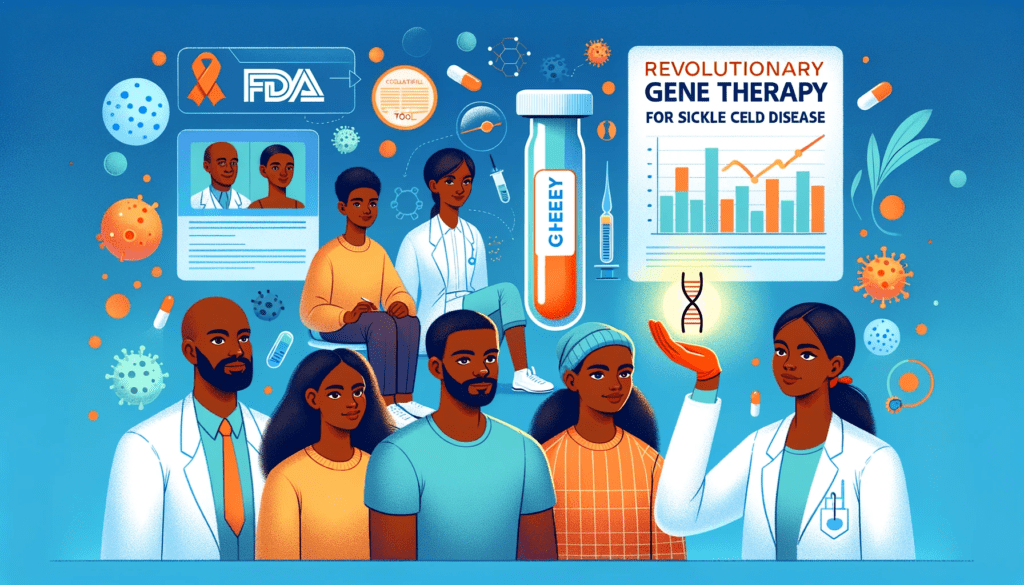
A New Frontier in Sickle Cell Treatment: How CRISPR and Gene Therapy Are Changing the Game
Exploring the revolutionary gene therapy for sickle cell disease that could be a game-changer for Black Americans, with insights into FDA approval, CRISPR technology, and clinical trials.
By Darius Spearman (africanelements)
About the author: Darius Spearman is a professor of Black Studies at San Diego City College, where he has been pursuing his love of teaching since 2007. He is the author of several books, including Between The Color Lines: A History of African Americans on the California Frontier Through 1890. You can visit Darius online at africanelements.org
Key Takeaways
| Topic | Insight |
|---|---|
| FDA Approval | The FDA is currently reviewing a new gene therapy for sickle cell disease. |
| CRISPR Technology | The therapy uses CRISPR gene editing to promote healthy hemoglobin production. |
| Clinical Trials | Initial trials have shown promising results, especially for Black Americans who are disproportionately affected. |
Introduction: The Urgency for a Sickle Cell Cure
Sickle cell disease is a relentless condition that disproportionately affects Black Americans. The disease distorts red blood cells into a sickle shape, leading to a host of complications like anemia, extreme pain, and even organ failure. The urgency for a cure has never been more palpable, especially considering that tens of thousands of Americans suffer from this disease every year. The vast majority of these are Black Americans.
“Sickle cell disease plagues tens of thousands of Americans every year, and the vast majority of those suffering are Black Americans.” (The Root)
The FDA has stepped into the spotlight, reviewing a potential gene therapy cure for this debilitating disease. This is a monumental moment in the medical field, especially for those who have been waiting for a breakthrough. The FDA’s involvement signals a serious commitment to finding a cure, and it could be a game-changer for many.
The FDA’s Role: A Beacon of Hope
The Food and Drug Administration (FDA) is not just a regulatory body; it’s a beacon of hope for those suffering from various ailments. In the case of sickle cell disease, the FDA is currently reviewing a groundbreaking gene therapy that could change lives forever.
“On Tuesday, the Food and Drug Administration is reviewing a potential cure that uses gene therapy to treat sickle cell disease.” (The Root)
The FDA’s decision is highly anticipated and is expected to come in early December. This could be the Christmas miracle that many have been waiting for. The FDA’s rigorous review process ensures that only the most effective and safe treatments make it to the public, making their endorsement a significant milestone in the journey towards a cure.
The Science: CRISPR Gene Editing
The CRISPR Revolution
CRISPR isn’t just a buzzword; it’s a revolutionary tool that’s the backbone of this new therapy. By promoting the production of healthy hemoglobin, CRISPR could be the key to unlocking a new era in sickle cell treatment.
“The gene therapy uses CRISPR, a gene editing tool, to help promote the production of healthy hemoglobin, a protein in red blood cells responsible for the complications from sickle cell.” (The Root)
How CRISPR Works
CRISPR works by cutting the DNA at a specific location and then adding or deleting genetic material. In the case of sickle cell disease, CRISPR targets the genes responsible for the production of the distorted hemoglobin, effectively replacing it with a healthy version. This is groundbreaking because it addresses the root cause of the disease, not just the symptoms.
Table: How CRISPR Works in Sickle Cell Treatment
| Step | Description |
|---|---|
| Targeting | Identifies the genes responsible for distorted hemoglobin. |
| Cutting | Cuts the DNA at the specific location. |
| Editing | Adds or deletes genetic material to produce healthy hemoglobin. |
Clinical Trials: Early Signs of Success
The Promise of Clinical Trials
Clinical trials are the litmus test for any new treatment, and in the case of this gene therapy. Early findings indicate that the therapy could be a viable solution for treating sickle cell disease.
“Although the technology is relatively new, findings from initial clinical trial of the technique published earlier this year, were promising.” (The Root)
What’s Next in Clinical Trials
The next phase of clinical trials will be crucial. Researchers will be looking at long-term effects, potential side effects, and overall efficacy. The trials will also focus on different age groups and varying severity of the disease, making it a comprehensive study that could pave the way for FDA approval.
List: Key Focus Areas for Next Phase of Clinical Trials
- Long-term effects of the therapy
- Potential side effects
- Efficacy in different age groups
- Efficacy in varying severity of the disease
The Painful Reality: Living with Sickle Cell
The Agony of Sickle Cell
Living with sickle cell disease is no walk in the park. The pain is often described as unbearable, akin to being stabbed all over your body. This is the grim reality for many, emphasizing the need for an effective treatment.
Coping Mechanisms
While waiting for a cure, patients often rely on pain medication, blood transfusions, and other temporary treatments to manage symptoms. However, these are not long-term solutions and come with their own set of complications, such as dependency and side effects.
Table: Common Coping Mechanisms for Sickle Cell Patients
| Coping Mechanism | Complications |
|---|---|
| Pain Medication | Dependency, Side Effects |
| Blood Transfusions | Risk of Infection, Iron Overload |
| Hydration | Limited Effectiveness |
Global and Ethnic Impact: Beyond the U.S.
The Global Scale
Sickle cell disease is not just an American problem; it’s global. The disease is more common in certain ethnic groups, making it a significant concern for global health organizations.
“Millions of people around the world, including about 100,000 in the U.S., have the disease.” (AP News)
Ethnic Disparities
In the U.S., the disease predominantly affects Black Americans, but it’s also prevalent in regions like Africa, the Middle East, and India. Addressing these ethnic disparities is crucial for the global eradication of the disease.
List: Regions with High Prevalence of Sickle Cell
- United States (predominantly among Black Americans)
- Africa
- Middle East
- India
The Treatment: A One-time Game Changer
A Revolutionary Approach
The new gene therapy is not just another treatment; it’s a one-time, potentially life-altering intervention. By permanently changing the DNA in a patient’s blood cells, this therapy could eliminate the need for ongoing treatments.
“No donor is required for the one-time gene therapy, ‘exa-cel,’ made by Vertex Pharmaceuticals and CRISPR Therapeutics.” (AP News)
The Companies Behind the Cure
Vertex Pharmaceuticals and CRISPR Therapeutics are the brains behind this groundbreaking therapy. Their collaboration could set a new standard in gene therapy, making it a transformative moment in medical history.
List: Key Players in the Development of the New Therapy
- Vertex Pharmaceuticals
- CRISPR Therapeutics
- FDA for regulatory approval
Safety and Efficacy: A Strong Profile
The Safety Measures
Safety is paramount when introducing a new treatment. The therapy has been tested in a relatively small number of patients. According to the company promoting it,
“The company called the treatment ‘transformative’ and said it has ‘a strong safety profile.'” (AP News)
The Efficacy Factor
While safety is crucial, efficacy is equally important. The treatment needs to not only be safe but also effective in alleviating the symptoms and potentially curing the disease. The strong safety profile is a promising indicator, but further studies are needed to confirm its efficacy.
Table: Factors to Consider for Safety and Efficacy
| Factor | Importance |
|---|---|
| Safety Profile | Must have minimal side effects and risks |
| Efficacy | Must effectively treat or cure the disease |
FDA Concerns: The Road Ahead
The FDA’s Scrutiny
The FDA’s review process is thorough and rigorous. One of the concerns they have is the possibility of “off-target effects.”
“The FDA is asking an outside panel of gene therapy experts next week to discuss a lingering issue that often comes up when discussing CRISPR: the possibility of ‘off-target effects.'” (AP News)
These effects could potentially cause unintended genetic changes.
The Need for More Research
While the initial results are promising, the FDA’s concerns indicate that more research may be needed. This could involve additional clinical trials or studies to ensure that the treatment is both safe and effective.
The Cost: A Price for Life
The Financial Burden
- Research and Development Costs
- Clinical Trial Expenses
- Regulatory Approval Costs
The cost of the new therapy is still unknown, but it’s expected to be high.
“The companies have not released potential prices for either therapy, but the institute report said prices up to around $2 million would be cost-effective.” (AP News)
List: Factors Influencing the Cost of the New Therapy
The Value of Life
While the cost may seem exorbitant, one must consider the value of a life free from the debilitating effects of sickle cell disease. For many, this treatment could be priceless, offering a chance at a normal life.
